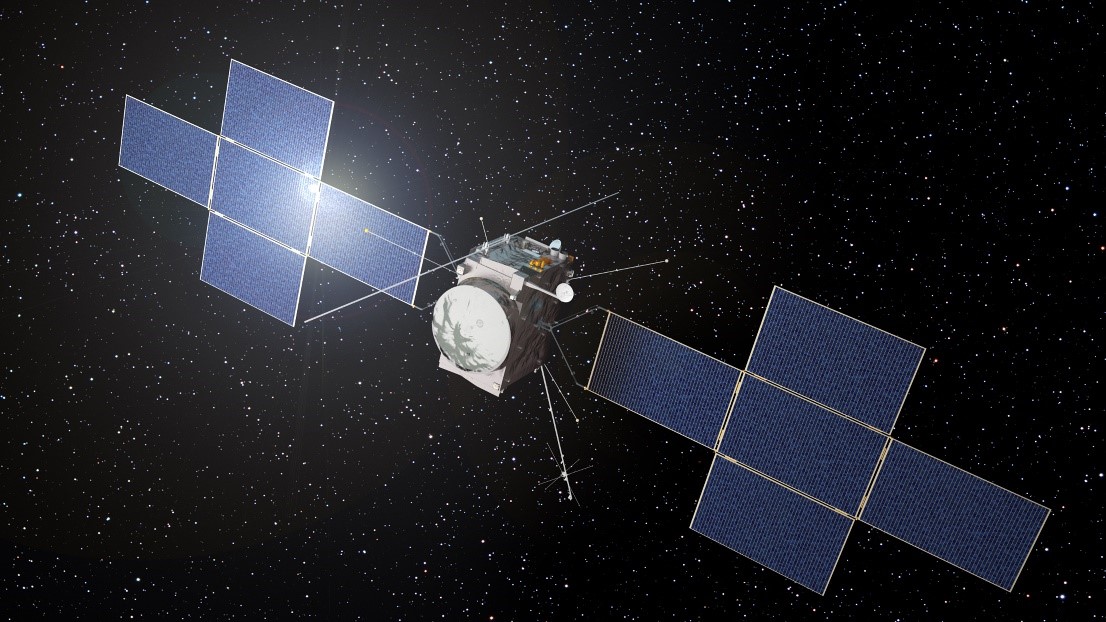JUICE – Jupiter Icy Moons Explorer
The 1st large-class mission within ESA’s Cosmic Vision Program
| Launch Date: | 14 April 2023 |
| Mission Duration: | 12 years |
| Mission Operator: | ESA |
| Location: | Jupiter |
| Arrival to Jupiter: | July 2031 |
Mission Objective
Conduct a study of three of the Galilean moons of Jupiter – Ganymede, Callisto, and Europa. The study will refer to the moons as both planetary entities and possible habitats. Furthermore, the study will involve an in-depth exploration of Jupiter’s environment and its system, serving as a prototype for gas giants throughout the Universe.
Mission Significance
- The Galilean moons are the four largest moons of Jupiter.
- These three moons, in particular, are believed to contain substantial liquid water reservoirs beneath their icy exteriors, suggesting the possibility of habitable environments.

Source: ESA
Mission Components
Jupiter lacks a solid surface. It consists mainly of swirling gases and liquids, making it impossible to land rovers or spacecraft on the planet. Therefore, the spacecraft’s design and payload are planned accordingly.
The JUICE spacecraft is a 3-axis stabilized platform.
Power subsystem: Solar Array
- Included: two wings of five panels each.
- The total surface area of the solar array: 85
- Amount of energy provided: 820
(At Jupiter under end-of-life conditions)
- Additional energy storage capabilities: Li-ion battery.
Telemetry system: High Gain Antenna
- Significance: routine operations, safe mode, and radio science investigations
- How: X and Ka-bands
- Diameter: 2.5
- Amount of scientific data per day: 1.4Gbits
Propulsion System: Bi-Propellant Main Engine
- Included: set of 10 thrusters
- Main Goal: include the Jupiter and Ganymede orbit insertion.

Source: ESA
Methodology Overview & Instruments
JUICE will use a range of instruments, including remote sensing and in situ tools, to conduct detailed observations of Jupiter and its three major ocean-bearing moons.
Number of instruments: 10
| Name: | JANUS | MAJIS | UVS |
| Instrument: | Camera system | Moons and Jupiter Imaging Spectrometer | UV imaging Spectrograph |
| Research objectives: | û Global and local morphology and processes on the moons
û Cloud mapping on Jupiter
|
û Observation of tropospheric cloud features
û Characterization of ice and minerals on the moons’ surfaces. |
û Characterization of the exospheres of the moons
û The Jovian aurora û Investigation of the upper atmosphere. |
| Name: | SWI | GALA | RIME |
| Instrument: | Sub-millimeter Wave Instrument | GAnymede Laser Altimeter | Radar for Icy Moons Exploration |
| Research objectives: | û Study various characteristics of Jupiter’s stratosphere and troposphere
|
û Study of the tidal deformation of Ganymede
û Study the morphology and topography of moons’ surfaces. |
û Study the subsurface structure of the moons (9km depth and 50m vertical resolution).
|
| Name: | J-MAG | PEP | RPWI | GM-3 |
| Instrument: | A magnetometer for JUICE | Particle Environment Package | Radio & Plasma Wave Investigation | Gravity & Geophysics of Jupiter and Galilean Moons |
| Research objectives: | û Characterization of the Jovian magnetic field and its interaction
û The subsurface oceans of the moons. |
û Characterization of the plasma environment in the Jovian system.
|
û Characterization of the radio emission and plasma environment of Jupiter and its moons
|
û Study the gravity field at Ganymede and of the moons.
|
TIMELINE
Visualization of JUICE’s journey

Where is JUICE now? Click here to find out!
________________________________________________________________________________________________
ACKTAR PARTS:
| Coating: | Substrate: | Instrument: |
| Fractal Black
Magic Black
|
Aluminum
Molybdenum Titanium |
3GM
PEP RPWI JANUS SWI |

